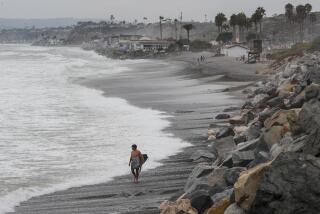Bird Ordinance Ruffles Feathers
WEST HAMPTON DUNES, N.Y. — The virtual closing by wildlife officials of a two-mile stretch of beach to protect the endangered piping plover isn’t flying well with residents.
“They’ve given the birds the beach,” said Tom Scionti, a 19-year resident. “I have nothing against these birds, . . . but they’ve carried this to an all-time extreme.”
In March, wildlife officers strung brightly colored fencing around vast sections of sand where the piping plovers nest for the summer. Big signs warn residents of $10,000 fines and jail time if they disturb a nest.
The action has effectively blocked off most of the beach in this affluent summer refuge on eastern Long Island. Beachfront property owners claim summer tenants have backed out of lease agreements--resulting in losses of $60,000 to $150,000 for the season.
The tiny village has filed a federal lawsuit seeking full access to the beach and $12.5 million in lost property values. The U.S. Fish and Wildlife Service, the Army Corps of Engineers and the state Department of Environmental Conservation are named as defendants.
“These birds may have rights, but human beings have rights too,” Mayor Gary Vegliante said.
The acrimony has risen to such levels that some residents have put bumper stickers on their cars that say “Piping plovers taste like chicken.”
Wildlife officials are concerned because the piping plover population is threatened along the entire Atlantic Coast. The number of birds has increased slowly since 1992, but any loss of nesting birds could affect the future population, experts say.
Glenn Smith of the Fish and Wildlife Service said that protecting piping plovers is one of the agency’s biggest challenges. “It’s contentious every summer,” said Smith, a biologist with the endangered species unit.
“Unfortunately, the time for nesting is the same time that people want to enjoy the beach,” he said. “People want to protect threatened species but not when they may be inconvenienced in their own backyard.”
The beach, though publicly owned, is accessible only through residential property.
Smith said the fencing is necessary to protect the birds, their eggs and their young chicks from being crushed, or so frightened that they stop eating.
“Unlike other birds, a plover chick’s natural reaction to a predator is to hunker down in the sand, where it could get squished by some dune buggy or by the foot of an innocent beach walker,” Smith said. Even a kite flying overhead can be viewed as a predator, causing a plover to stop feeding.
To avoid the restricted area, beachfront residents must drive about two miles to one of two publicly accessible beaches, or walk hundreds of yards to one of eight narrow access ways that allow them to walk to the high-tide mark.
“Did you ever try that on a hot day with a screaming toddler, umbrella, cooler and an elderly mother-in-law in tow?” asked Scionti, whose house overlooks the beach.
The sandy-colored birds began nesting on the beach here in 1991. That was the year erosion from a nor’easter caused a severe breach, allowing seawater to wash over the beach into the bay.
Biologists believe the mild-mannered birds were attracted to the site because flat, washed-over beaches are ideal nesting areas. They are not sure why the plover’s numbers have increased so much over the last decade, making this one of the country’s most productive breeding grounds for piping plovers.
This season there are 38 nesting pairs and 35 chicks here, said Aram Terchunian, a coastal geologist and the village’s commissioner of wildlife protection. In all, an estimated 1,400 nesting pairs are summering on the Eastern Seaboard from Canada to South Carolina.
Over the years, the community’s 500 residents have peacefully coexisted with their feathered friends, signing an agreement in 1995 to allow federal officials to fence a nest once it was established.
“We’ve been very hospitable to these birds,” said John O’Connell, attorney for the village. “We said they could fence the nests, but not the entire beach.”
The village also spends $20,000 a year--about 15% of its annual budget--to hire a plover patrol to protect the birds and their eggs from predators.
The plovers lay their eggs in April and usually stay through July before heading to Florida or South America. The plovers return to virtually the same spot each summer to nest, said Peter Weppler, a biologist with the Corps of Engineers.
“There is no villain here,” Weppler said, “just the intersection of two elements--recreational and ecological. The plover and people can coexist.”
More to Read
Sign up for Essential California
The most important California stories and recommendations in your inbox every morning.
You may occasionally receive promotional content from the Los Angeles Times.










